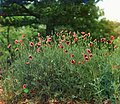Poppy
| Papaveraceae | |
|---|---|

| |
| Papaver rhoeas | |
| Scientific classification | |
| Kingdom: | |
| Division: | |
| Class: | |
| Order: | |
| Family: | |
| Subfamily: | Paperveroideae
|

A poppy is a flowering plant in the subfamily Paperveroideae.
The name is used especially for the bright red flowers which are common in this group. They are symbolic, and used to remember the Armistice Day of World War I, now known as Remembrance Day. Now it is celebrated in the Commonwealth for those who died in all wars.
Some types can be grown and used to make the drug opium. Ancient Egyptian doctors had their patients eat seeds from a poppy to relieve pain. Poppy seeds contain small quantities of both morphine and codeine.[1] These are pain-relieving drugs that are still used today. The morphine practically disappears from the seeds twenty days after the flower has opened, so from then on poppy seeds and their oils are not narcotic.[2] There are a number of showy flowers, typically one per stem, in to the poppy family. They include a number of attractive wildflower species with showy flowers growing singularly or in large groups. Many species are grown in gardens. These include large plants used in a mixed herbaceous border and small plants that are grown in rock or alpine gardens.
The flower color of poppy species include: white, pink, yellow, orange, red and blue. Some have dark center markings. The cultivated species include many other colors ranging from dark solid colors to soft pastel shades. Before blooming, the petals are crumpled in bud, and as blooming finishes, the petals often lie flat before falling away.
The pollen of the oriental poppy, Papaver orientale, is dark blue. The pollen of the field poppy or corn poppy (Papaver rhoeas) is dark blue to grey. Bees use poppies for their pollen.
The opium poppy, Papaver somniferum, is grown for opium, opiates or seeds to be used in cooking and baking.
Gallery
[change | change source]-
Bhutan's national flower
-
Close-up of an Oriental poppy (Papaver orientale).
-
Immature crowning Opium Poppy, top view.
-
A poppy bud opening.
-
Papaver somniferum seeds.
-
Field of poppies.
Related pages
[change | change source]References
[change | change source]- ↑ Meadway C; George S. & Braithwaite R. 1998. Opiate concentration following the ingestion of poppy seed products – evidence for 'the poppy seed defence'. Forensic Science International 96, 29–38.
- ↑ Kryzmanski J. and Jonsson R. 1999. Poppy. In: Robbelon G. et al eds, Oil crops of the world. their breeding and utilization. McGraw Hill, New York, p. 388-393. ISBN 00-705-30815
Text is available under the CC BY-SA 4.0 license; additional terms may apply.
Images, videos and audio are available under their respective licenses.






